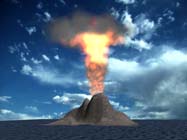1600 volcanic eruption in Peru had a global impact on human society
 Washington, April 24 : A new study by geologists at UC Davis has suggested that the 1600 eruption of the volcano Huaynaputina in Peru had a global impact on human society.
Washington, April 24 : A new study by geologists at UC Davis has suggested that the 1600 eruption of the volcano Huaynaputina in Peru had a global impact on human society.
The 400-year-old eruption is known to have put a large amount of sulfur into the atmosphere, and tree ring studies show that 1601 was a cold year, possibly a result of the climatic event.
Sulfur reacts with water in the air to form droplets of sulfuric acid, which cool the planet by reducing the amount of sunlight reaching the Earth’s surface. But the droplets soon fall back to Earth, so the cooling effects last only a year or so.
According to Ken Verosub, professor of geology at UC Davis, “We knew it was a big eruption, we knew it was a cold year, and that’s all we knew.”
Verosub and student Jake Lippmann combed through records from the turn of the 17th century from Europe, China and Japan, as well as the Spanish and Portuguese colonies in South America and the Philippines, for information about changes in climate, agriculture and society after the 1600 eruption.
In Russia, 1601-1603 brought the worst famine in the country’s history, leading to the overthrow of the reigning tsar. Records from Switzerland, Latvia and Estonia record exceptionally cold winters in 1600-1602.
In France, the 1601 wine harvest was late, and wine production collapsed in Germany and colonial Peru. In China, peach trees bloomed late, and Lake Suwa in Japan had one of its earliest freezing dates in 500 years.
“In one sense, we can’t prove that the volcano was responsible for all this,” said Verosub. “But we hope to show that 1601 was a consistently bad year, connected by this event.”
Verosub hopes to expand the study by examining records kept by the Jesuit order in Seville, Spain, and from the Ming Dynasty in China. (ANI)